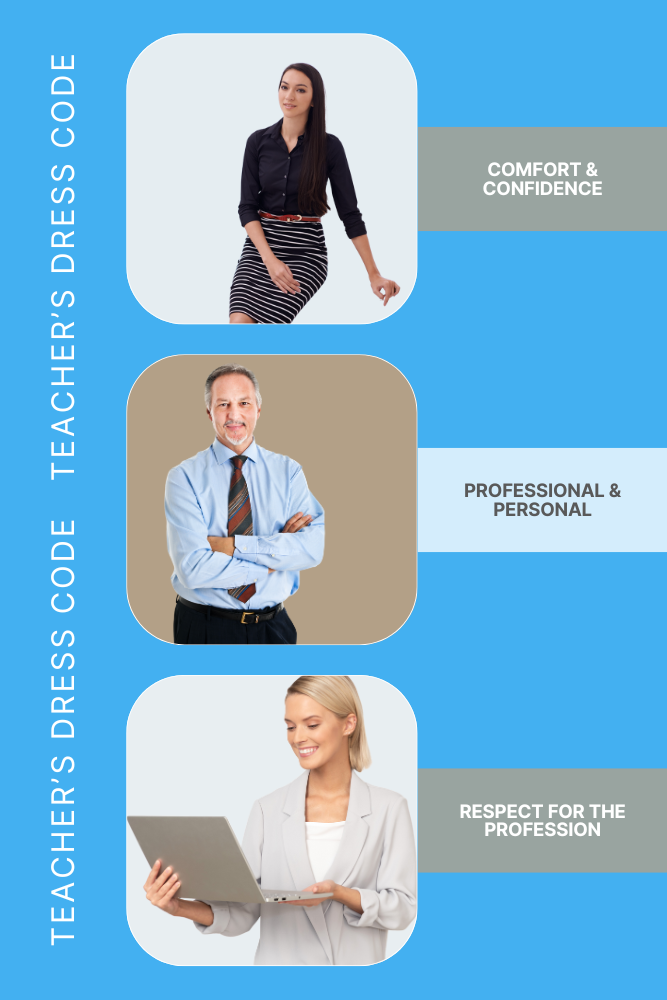Beginning a Journey with Stylish and Confident Teacher’s Dress Code.
Navigating the teacher’s dress code is crucial for new teachers. Starting your teaching career is thrilling. You’ll shape minds and enhance school life. Mastering teacher attire is key. It builds a positive, authoritative classroom presence. This guide offers support and practical tips. It aims to boost your confidence in choosing outfits. Feel prepared and respected every day. Together, let’s see dress codes as opportunities for expression. But first, follow the Lead Teacher Tips on tiktok:
Understanding Your School’s Dress Code.
Understanding and adhering to your school’s dress code is essential in integrating into the educational community and developing your professional identity as a teacher. A strategic approach to wardrobe can significantly impact your classroom appearance and the respect you receive from students and coworkers. Viewing the dress code as a framework provides confidence and professionalism, allowing you to make informed clothing decisions that align with the school’s ethos and personal style. This section offers tips and tools to help you negotiate your school’s dress code efficiently.
What Does My School’s Teacher’s Dress Code Really Mean?
Navigating your school’s dress code entails more than just following a list of do’s and don’ts; it’s about comprehending the ethos and ideals the code represents. It displays a dedication to professionalism and respect in the educational community, consistent with the Australian Professional Standards for Teachers, particularly in terms of professional involvement. To fully understand what your school’s dress code involves, engage in two crucial activities:
-
- Observation: Pay attention to your experienced colleagues, noticing how they blend professionalism with personal flair and how their wardrobe affects their interactions with students and staff.
-
- Dialogue: Start conversations with your mentors or administrative staff to clarify any dress code ambiguity. This proactive approach not only helps you follow the criteria but also reflects your commitment to professional standards.
How Can I Adapt My Teacher’s Dress Code While Maintaining My Personal Style?
A teacher I once supervised called Alex. She was a new teaching graduate bewildered by the term “business casual.” By observing the clothes of respected coworkers and adding pieces of her style into her own outfits, Alex created a professional yet unique look. For example, she chose well-fitted slacks and combined them with blouses in soft, approachable tones, finishing with a distinctive scarf or unique piece of jewellery. This strategy enabled Alex to blend effortlessly into the school atmosphere, garnering the respect of both colleagues and students while remaining authentic and comfortable in her own skin. It demonstrates that there is plenty of freedom for unique expression within the context of professionalism.

Balancing Professionalism and Personal Style
A successful teaching persona requires striking the correct balance between professionalism and personal style. It entails presenting an image that corresponds to school dress standards while allowing personality to shine through. This balance promotes comfort and confidence and focuses on teaching and student interactions. Professional apparel reflects respect for the profession, whereas personal style makes the instructor more relevant and approachable. This approach assists in identifying a distinct style for a healthy educational setting.
How Can I Strike the Right Dress Code Balance Between Professional and Personal?
Achieving a balance between professional duties and personal flair is critical for educators. It is about creating an image that commands respect while still allowing your personality to peek through. To accomplish this:
-
- Dress comfortably and appropriately for the dynamic school atmosphere, allowing you to actively engage with your children.
-
- Incorporate personal features, like a signature scarf or a unique pair of spectacles, that express your personality while remaining professional.
This balanced approach not only improves your professional image but also makes you more relatable to your students, resulting in a great learning environment.
Where Can I Find Inspiration for My Teaching Wardrobe?
Inspiration for your teaching clothing can be obtained in several places:
-
- Educational Style Blogs: These platforms frequently give educators valuable insights and seasonal style ideas.
-
- Social Media: Platforms such as Instagram and Pinterest are populated with teacher fashion influencers who share their daily attire, offering real-world inspiration.
-
- Peer Inspiration: Remember to consider the importance of your colleagues’ styles. Talk about where they shop and how they chose their teaching attire.
Combining these sources can provide you with diverse ideas to pull from, allowing you to fine-tune your personal style within the professional environment.
Addressing Common Teacher’s Dress Code Questions and Concerns
This section discusses typical issues concerning teacher costume in education, focusing on practical recommendations for maintaining a professional image that may be applied to various educational circumstances. It answers typical matters and provides advice on handling wardrobe dilemmas, allowing teachers to concentrate on teaching rather than what to wear. This helps teachers adhere to their school’s dress policy and project a professional image.
Can I Wear Jeans and Other Common Teacher’s Dress Code Questions
Jeans in a classroom? This prevalent question among instructors is met with varied responses depending on the school’s culture and dress code requirements. If your school allows jeans, choose a darker wash that looks more formal and combine them with a smart top or blazer to retain a professional appearance. The objective is to ensure that your overall appearance reflects the school’s requirements of professionalism and dignity.
What Are the Do’s and Don’ts for Avoiding Mistakes in the Teacher’s Dress Code?
How to properly manage the dress code:
| DO | DON’T |
| Accept the school’s ethos. Choose elements that reflect both your professional job and the school’s culture. |
Avoid excessively casual or distracting items, as these may weaken your authority or the learning atmosphere. |
Developing Your Educator Identity with Confidence and Style
Your journey as an educator is defined not only by the teachings you teach but also by the image you portray. Adhering to the dress code but incorporating your personal style allows you to create a professional image that exudes respect, approachability, and sincerity. By following the rules, obtaining inspiration, and managing typical wardrobe challenges with discernment, you may turn your clothing into a strong tool for effective classroom involvement. Make every day an opportunity to show oneself as a passionate and relatable educator, ready to inspire the future generation with confidence and flair.
